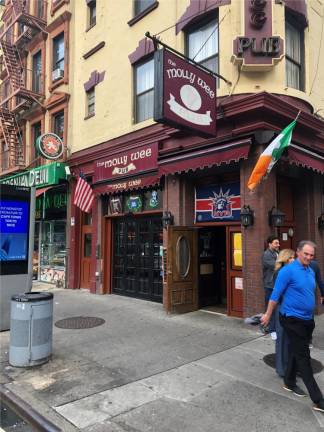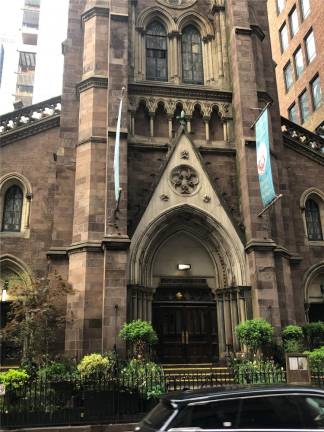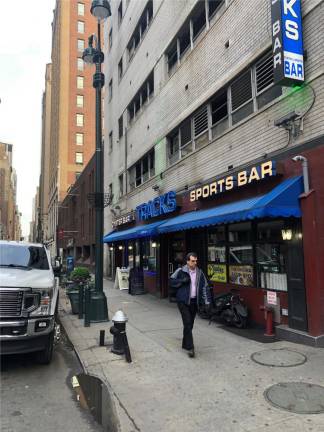Amtrak: Penn Station Needs to Expand Beyond Current Footprint
Amtrak, the owner of Penn Station, is telling transit and community activists that expansion of the station to accommodate future trains from New Jersey, is all but impossible without tearing down buildings south of the station. Some advocates still remain hopeful that Amtrak will embrace the concept of “through running” trains that don’t end at Penn.



Amtrak told a group of transit and community advocates that their proposals for expanding train service in and through Penn Station without tearing down adjacent blocks will not produce enough new capacity to meet surging demand expected from New Jersey commuters in the years ahead.
The railroad, which owns Penn Station, presented this analysis at a meeting with groups that have been fighting plans to accommodate the expected growth of service by the demolition of the block immediately south of Penn Station, often referred to by its tax number block 780.
Instead of extending the station to the south, the advocates have argued, Amtrak and the commuter railroads that share Penn Station should alter their operations to run trains from New Jersey through to Long Island and Westchester, and vice versa, increasing capacity without expanding the footprint of the station.
At the meeting, co-hosted by the Regional Plan Association and The Municipal Arts Society, Amtrak presented a consultant’s analysis of these so-called “through-running” proposals, measuring them against the goal of increasing service from the current 24 trains an hour to 48 trains an hour.
“The point was to say, ‘can you first solve for the capacity needs within the confines of the station’,” explained Tom Wright, President of the Regional Plan Association.
“His conclusion was, no, you can’t.”
The analysis was conducted for Amtrak by an independent transportation consultant, Foster Nichols, of the firm WSP. He examined two proposals by local advocacy groups, one from ReThinkNYC and the other from the Tri State Transportation Campaign.
Amtrak’s analysis concluded that Tri-State’s plan would increase capacity to 37 trains an hour and Rethinks to 42 trains an hour.
The head of ReThink, Samuel Turvey, said he thought the meeting represented progress. “We think the gap between our number and their number can be narrowed even further or eliminated,” Turvey added. “We would like to explore this further with the Railroads in a collaborative exercise using Rail Traffic Controller software capacity calculations so that we can take as much opinion out of this as possible.”
Turvey noted that while the Amtrak analysis was focused on increased service from New Jersey, ReThinks plan would also increase capacity from Long Island by six trains per hour at rush hour.
“Most importantly, through-running–which will allow for the inauguration of unified regional rail–will provide transformative and equitable economic, environmental and quality of life benefits to all 20 million plus regional residents and will not call for the demolition of blocks south of Penn Station,” Turvey said.
The Amtrak analysis, however, drew a more complicated picture. It noted that through running could in its way be just as complicated a construction effort as expanding Penn Station. It would require, for example, new rail yards on both sides of the Hudson and rebuilding of tunnels under the East River.
“Folks kind of assume anything that doesn’t include an expansion of the station is going to be much cheaper and faster and easier to do than anything that does include an expansion of the station,” Wright said, “and I don’t think that that holds up. One of the points Foster made is that you’re talking about building new rail yards in communities that are probably not excited about having rail yards built in their backyards. You’re talking about trying to untangle tunnels that we can’t really figure out how to untangle.”
Amtrak officials emphasized that no final decisions have been made about expanding the station, or even any deadline set for when a decision needed to be made. They declined to release the WSP report saying they wanted to show it first to elected officials.
Demolishing block 780, with its businesses, apartment buildings and a Catholic church, is only one of several approaches to expanding the station, officials said.
“Amtrak was pleased to join yesterday’s meeting with stakeholders interested in the issue of through-running at New York Penn Station,” said Petra Messick, the railroad’s senior program director. “We appreciate the thoughtful, meaningful dialogue and look forward to continued discussions around the goal of increasing rail ridership as an alternative to driving to and from Manhattan.”
The issue is driven by projections of population growth in New Jersey that will create more trips–by car, train or bus–to and from Manhattan. Robert Passwell, a transit expert and City College professor who attended the meeting, noted that his own grandson had moved his family from New York for more affordable housing, meaning he had to travel to New Jersey to see them.
Half of all the new housing under construction in the region is in New Jersey.
This challenge of growing demand for service into Manhattan has in many ways been overshadowed by the debate over the future of the Penn Station train hall, one of the more unpleasant rail stations in the world. There have been various competing proposals for a new train hall, some of which call for moving Madison Square Garden, which has sat on top of the station since 1968.
That all remains unresolved, but at the meeting with the railroads, their consultant made clear that moving the Garden would have only limited impact on the ability to run more trains through Penn Station.
That is because only a portion of the columns that crowd the platforms in Penn Station could be removed if the Garden was moved. The rest support 2 Penn Plaza and other adjacent structures.
While Amtrak has set no deadlines for decision on expanding Penn Station, a key date in 2038. That is when completion is projected for the Gateway Project, which is improving rail facilities in New Jersey and running two new tunnels under the Hudson, doubling capacity from two to four and making increased service to Penn Station possible.
Wright said the impetus for the meeting was actually a ceremony last fall in which many people gathered to celebrate ground-breaking for a key part of the Gateway project.
“Sam Turvey and the rethink people are outside protesting and what their concern is is that they feel like there being shut out by Amtrak,” Wright recalled.
“My sense is what was really happening is that Amtrak and the MTA and New Jersey Transit have been on the cusp of starting this process to talk about the station for a long time. But there were so many things for them to work out amongst themselves that that kind of official process hasn’t kicked off,” Wright said.
“I said to some of the Amtrak folks, ‘all these groups have put these proposals on the table and they’re frustrated that nobody’s responding to them,” Wright recalled. “And Amtrak said ‘no, we are taking them very seriously we just don’t have a forum to dialogue with them.’ I said, ‘geez what if some private civic groups invited you to their meeting to talk to folks? That was the basic idea about yesterday’s meeting.”